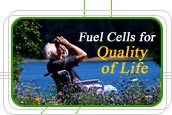DCH/Enable
TM stationary fuel cells are
optimized energy systems typically delivering from one to 10
kilowatts of clean electric power. Since the technology is
scalable, higher-power outputs are readily obtained by
expanding and integrating the number of proton exchange
membrane (PEM) stacks (right).
Like the Enable
TM portable fuel cells, these large
powerplants run on hydrogen — either directly in the form of a
gas, or from a system-integrated reformer that generates
hydrogen from a variety of common fuels, including natural gas
and propane. Unlike our portable fuel cells, the system
integrates several onboard pumps and motors used to move
hydrogen and air within the system to enable higher levels of
power.
Enable
TM
stationary fuel cells offer proprietary advantages over
competitive systems for applications in remote power,
auxiliary power, back-up power, power quality, and more —
including extremely fast response time, rapid start-up,
internet connectivity, very high efficiency, and very low
power requirements on stand-by.
Enable
TM engineers worked closely with a
leading R&D organization for the world's power utilities
to develop the fuel cell pictured on the right. Tied to the
grid, it reacts virtually instantaneously to compensate for
the varying loads — on the order of 75 microseconds — and thus
serves as an excellent power quality system. It produces 3
kilowatts of electrical power (the design is scalable to
higher wattages), delivered to a 200 VDC load, 400 VDC load,
or 208 VAC line or load.
An Enable
TM 3kW unit delivered to the Texas
Natural Resource Conservation Commission (
displayed
below) represents our second generation design — featuring
fewer parts, fewer connections, and made rugged for moving by
trailer to remote locations.
Our latest third
generation design, recently introduced to the market, raises
the bar in terms of its compact size, reliability and power
density.



